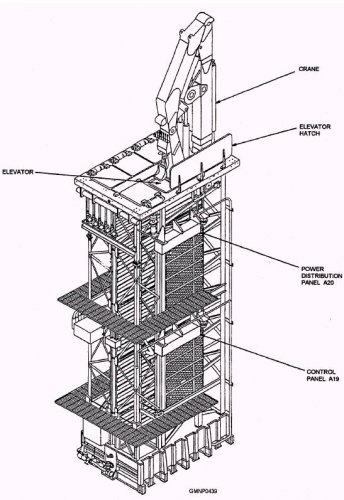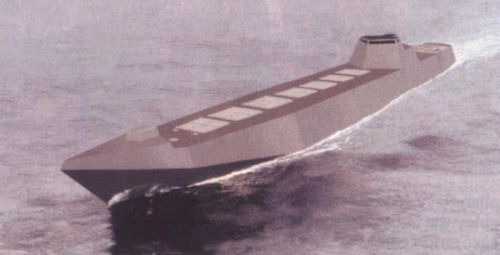After 50 years as the global symbol of America's military might, the aircraft carrier may soon be shoved off center stage by a new warship that would be able to rain 500 missiles within a matter of minutes on targets hundreds of miles away, without risking pilots' lives.
Prospects for that ship, which is still on the drawing board but could be in the fleet within five years, raise questions about how many new carriers the Navy will need. A carrier costs $4.5 billion to build and $440 million a year to operate. The new ship, essentially a floating missile barge, might cost only $500 million and just tens of millions a year to run.
The new ship would fire Tomahawk cruise missiles, long-range artillery shells or rocket barrages against ammunition dumps, command posts and artillery, for instance, the same targets that warplanes flying off the carrier Roosevelt were bombing in Bosnia this week.
The nation's existing armada of warships, submarines and carrier-based fighter-bombers was built to fight the Soviet Union. The Navy of the future, however, will have to deal with a broader range of potential threats, from Iranian cruise missiles blocking access to Persian Gulf oilfields to a surprise attack on Seoul by North Korea to another showdown with Saddam Hussein.
Given declining military budgets, Americans' aversion to casualties among their pilots and other combat forces, fast-improving anti-aircraft missiles and a new Navy doctrine that foresees fighting more wars near shore than out at sea, the Navy's top admiral, Jeremy M. Boorda, wants an inexpensive, versatile vessel bristling with firepower.
"I want it cheap and with lots of missiles," Admiral Boorda, the Chief of Naval Operations, said in an interview. "This is certainly a modern equivalent to the battleship."
Unlike the big-gun behemoths that slugged it out with Japanese warships in World War II or belched Volkswagen-sized shells during the Korean War, the Navy's newest dreadnought would lurk safely off a hostile shore, partly submerged to avoid detection, and rain 500 or more precision-guided missiles on enemy tanks, advancing troops or other targets. It could prove particularly valuable in the early stages of a crisis, before ground troops were in place.
It would travel with other ships and submarines for protection, and target information would be provided by other vessels, reconnaissance aircraft, pilotless drones or ground spotters.
The 825-foot arsenal ship, as its Navy designers call it, might require fewer than 20 people to operate, compared with the 5,000 aboard a 1,040-foot carrier. It would be equipped with the latest automated damage-control and firefighting systems, Admiral Boorda said. Borrowing from commercial supertanker designs, it would have two sets of double hulls, allowing it to take a hit from a missile or a torpedo and keep on sailing.
Andrew Krepinevich, director of the Defense Budget Project, a research organization in Washington, said: "The arsenal ship is the same challenge to aircraft carriers as the first carrier was in the 1920's to battleships. It's not going to make the carrier extinct overnight, but it will make it a less important part of the battle fleet."
Army and Marine commanders applaud the idea of an arsenal ship, because it would support ground troops. But the idea has plenty of skeptics inside and outside the military.
"It looks like the Navy is searching for a mission," said one Air Force colonel, a planning specialist. "They've put all their eggs in one basket and created one really lucrative target for an enemy."
Norman Polmar, a naval expert and author in Alexandria, Va., said: "It's an interesting idea, but when will you ever want to fire 500 Tomahawk missiles? There's no analysis to support that number of missiles."
Admiral Boorda's plan has touched off a struggle within the Navy itself. Some naval aviators feel threatened because the arsenal ship could grab some of their missions and glory. "If they aren't a little nervous, they are fools," said one officer involved in the planning.
Further, the new ship would be assuming a mission that submarine commanders believe Trident missile subs would otherwise be able to perform. They have pitched a submarine-featured counterproposal to Admiral Boorda, but are not optimistic. "This is going to be Boorda's legacy to the Navy, at least in his mind," one submarine officer said.
Admiral Boorda, the first enlisted sailor ever to rise to the Navy's top uniformed post, dismisses such talk and says an arsenal ship would be only one in a whole family of new ships. And he denies that it will replace the carrier or piloted missions any time soon. "I don't think so," he said. "Certainly not given the technology I envision in the next 20 to 30 years."
hile Admiral Boorda says he has made no final decision to build the arsenal ship, other senior Navy officials say that serious planning could start later this year and that the fleet, which has 12 carriers, could receive the first of as many as half a dozen of the new vessels within five years.
Navy officials are hoping to build the new ship using commercial business practices, cutting through military red tape and holding down costs. By keeping the concept and the design decidedly simple, Admiral Boorda aims to keep the arsenal ship affordable.
"This ship is not a command-and-control center, and it's not making big decisions," Admiral Boorda said. "It's simply the artillery battery. It matches our strategy pretty darn well."
That strategy is to fight closer to shore, against mines, coastal targets or armies farther inland. "The ability of sea-based forces to influence the outcome of land campaigns will become increasingly important," said Michael Vickers, a fellow at the Johns Hopkins School of Advanced International Studies.
Admiral Boorda envisions positioning arsenal ships at trouble spots around the world and rotating the small crews every six months. ("It would be part of your forward presence," he said.) That would reduce the costs that carriers now incur in training and in sailing to their assignments.
Navy planners must still work out a few important matters before they rush their blueprints to the shipyard. Admiral Boorda said that the automated systems needed more work and that the Navy must design a one-size-fits-all launching tube for the more than 15 types of missiles and rockets the ship could fire.
"This is not just taking a bunch of things off the shelf," he said, "but it's not as difficult as a lot of other technology projects."
The biggest challenge may be paying for the ship. The arsenal ship would be cheap by Navy standards, but military budgets are tight even with a more generous Republican Congress, and Admiral Boorda does not want to sacrifice other programs to pay for this one.
The Navy is seeking financing from the Pentagon's Advanced Research Projects Agency, which develops new technology. "We're looking at a year or two of thinking and discussion," said Larry Lynn, the agency's director, who declined to say how much the agency might invest in the project.
One way or another, though, Admiral Boorda will most likely get his ship. "This is a good idea," he said, "and it's worth pursuing."





